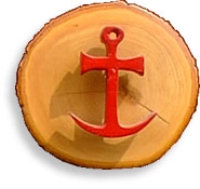The cross symbol has been a vital influence in the worship and lives of Christians. Here are seven historical forms of the cross explained and interpreted for today. Each page includes the history of the particular cross, a meaningful devotion and suggested daily reading for personal meditation. The sign of the cross series can serve as the basis for Lenten devotions, sermons, worship, or study.
Anchor Cross – Hope
The Sign of the Cross
"This hope we have as an anchor of the soul, a hope both sure and steadfast and one which enters within the veil." - Hebrews 6:19In this Lenten season, as we think about the cross, it is surprising to learn this now universal symbol of Christianity was not immediately recognized as an emblem of our faith. In fact, the cross did not come into use to any extent until almost three hundred years after the death of our Lord.
The reasons the cross was not readily adopted were probably twofold. First, generations of Christians in the first three centuries of the church's history were constantly persecuted, so any identifying symbols had to be concealed. The use of the cross would have marked early followers for martyrdom like Christ.
The second reason the cross was ignored was that it was associated with the execution of criminals. As such, it was a despised reminder of disgrace rather than an object of reverence. Death by crucifixion was a shameful embarrassment. That Christ was put to death in this fashion was a humiliation. It was generations, evens centuries before this felling was overcome.
Anchor Cross
 There are crudely carved crosses in the early underground burial places of the catacombs of Rome. Tradition claims they were made by Christians, bit there is no proof when they were made nor is there any historical record when the cross was actually first used.
There are crudely carved crosses in the early underground burial places of the catacombs of Rome. Tradition claims they were made by Christians, bit there is no proof when they were made nor is there any historical record when the cross was actually first used.
We do know that about AD 325 and after Emperor Constantine was converted to Christianity, the cross was first used publicly and placed in early churches. Individual Christians may have erected devotional crosses in home worship centers before that time. However, it was not until about the ninth century that it was regarded was a widespread symbol of our religion.
The anchor, on the other hand, seems to be a well established early Christan symbol. Its origin can probably be traced to the text quoted above from the letter to the Hebrews (Heb 6:19). It was a favorite of the faithful because of its similarity to the cross shape which is an integral part of the anchor design.
Indeed, the anchor is one of the oldest Christian symbols. Clement of Alexandra (c. 150-c. 215), while condemning the common use of symbols, gave his approval to the use of the "ship's anchor" as a unique seal of the faith.
The Ship and the Church
The boat and other marine objects such as nets, fish and metaphors of "catching converts" have also been employed to convey the Gospel. The ship identified the church, wrote Clement of Rome (about AD 96) for its whole business is "bearing through a violent storm the faithful of many places and who desire to inhabit the city of the good kingdom." It's also interesting to note that the main part of the church's architecture from the chancel to the entrance is called the nave, a term from Latin meaning "ship."
 As an anchor cast into the sand holds a ship securely, so hope, even in the midst of suffering, distress, oppression, or deep sorrow remains firm. It provides safety ans sufficiently sustains the inner person, though in the eyes of the world it may seem a weak support. Poets have frequently reminded us of this symbol, such as Tennyson, who wrote in Enoch Arden, "Cast all your cares upon God, that anchor holds."
As an anchor cast into the sand holds a ship securely, so hope, even in the midst of suffering, distress, oppression, or deep sorrow remains firm. It provides safety ans sufficiently sustains the inner person, though in the eyes of the world it may seem a weak support. Poets have frequently reminded us of this symbol, such as Tennyson, who wrote in Enoch Arden, "Cast all your cares upon God, that anchor holds."
We need symbols that point beyond themselves tot he strength and comfort Christ continues to offer. The ship and the anchor are simple things that we can grasp and they can grasp us. They bring to mind the inner spiritual resources that nourish our trust in the future. An anchor keeps us from drifting astray in the storms of life so we can press on to tour true destination. In Christ we have an eternal anchor who holds us firmly in hope of salvation.
Meditation and Further Reflection
O Lord, I thank you for new symbols that open our lives to deeper dimensions of meaning; and for ancient signs like the anchor and cross which still speak to us of hope, while we are surrounded by confusion. When I see a ship's mast aI associate it with a cross, your cross. Perhaps it is a forced association, bit it nonetheless has deep personal significance to me.
Many thoughts of ships and boats run through my mind, o Lord. I recall Noah's Ark, the shipwrecks of the Apostle Paul, and the boat you often used to preach from the shore of the Sea of Galilee. Perhaps it was the same craft that transported You across the sea, away from demanding crowds to a lonely place to be by yourself.
 I also recall the story of the storm at sea when the disciples were afraid and You calmed the weather. We realized then and now that You are Lord of all life, for even the natural elements obey your command. And finally, I remember the great fish stories of Jonah in the Old Testament and of Your frustrated followers after Your death who caught nothing in their nets until You gave them faith and confidence and told them where to fish.
I also recall the story of the storm at sea when the disciples were afraid and You calmed the weather. We realized then and now that You are Lord of all life, for even the natural elements obey your command. And finally, I remember the great fish stories of Jonah in the Old Testament and of Your frustrated followers after Your death who caught nothing in their nets until You gave them faith and confidence and told them where to fish.
Like them in their mission, once in a while, I too get frustrated about life, about the church, or about my work. Sometimes things don't seem to fall into place to my advantage and I get upset, impatient, and overly concerned. At times like that, it's good to be reminded that You are Lord over all life, that we can anchor our hopes entirely in You and our trust will not be disappointed. Thank You for gathering us in the community and mutual support of Your ship, the church for friends in faith who share our troubles and offer understanding and active help. I'm grateful, Lord, and appreciate the opportunity to contemplate the cross in this Lenten season. Amen.
Readings:
- Sunday - John 21:1-25
- Monday - Genesis 6:1-9:29
- Tuesday - Acts 27:1-66
- Wednesday - Matthew 14:1-36
- Thursday - Jonah 1:1-4:11
- Friday - Mark 4:1-41
- Saturday - John 6:16-59
Hear the Message
Send This Page to a Friend
© 2012, Dr. Neal Carlson. All Rights Reserved.
Designed & maintained by TerryB & Associates
Designed & maintained by TerryB & Associates
 Tau – Repentance
Tau – Repentance Maltese – Protection
Maltese – Protection Jerusalem – Healing
Jerusalem – Healing Anchor – Hope
Anchor – Hope Celtic – Mission
Celtic – Mission Latin – Suffering
Latin – Suffering Cross & Orb – Victory
Cross & Orb – Victory